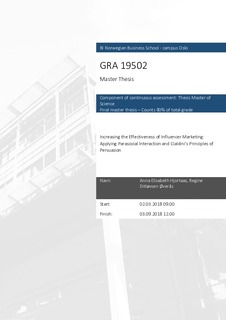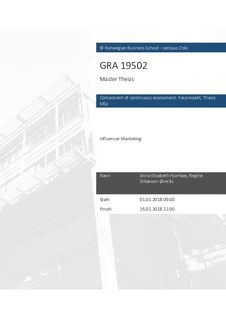| dc.description.abstract | This study examines whether parasocial interaction (PSI) (Horton & Wohl, 1956)
and the Principles of Persuasion (Cialdini, 1984) can be applied to increase the
effectiveness of influencer marketing. Whereas PSI seeks to explain how and why
people are influenced by others, Cialdini’s research provides a guideline to how the
principles of liking, reciprocity, social proof, consistency, authority and scarcity
can be harnessed to provoke the mechanisms leading to influence.
Serving each their purpose, the theories are carefully integrated in a joint framework
functioning as an influencer marketing guide. The authors test whether the
principles of likability, expertise and consistency are influencer characteristics that
increase the level of PSI. Subsequently, the principles of reciprocity, scarcity and
social proof are tested in order to explore whether they serve as persuasion
techniques that increase purchase intention (PI). In accordance with the proposed
framework, the latter principles are tested separately and when interacting with PSI.
The study approaches a sequential exploratory research design, where a qualitative
method is followed by a quantitative method. With influencer marketing being a
somewhat new topic to undergo study, three qualitative studies were conducted
introductory. Subsequently, the ten hypotheses substantiating the proposed
framework were tested through a quantitative study, using an online questionnaire.
The questionnaire was distributed through Facebook and received 358 respondents.
The findings indicate that PSI relationships can be developed towards influencers
in social media. PSI relationships are further found to positively affect PI,
confirming previous research on the topic. Reviewing influencer characteristics,
liking and homophily serve as significant contributors to the development of PSI
relationships. These findings extend prior applications of PSI to the field of
influencer marketing. Rereading persuasion techniques, when used in influencer
marketing, scarcity is found to positively impact PI. The study contributes with
insights to how PSI, influencer characteristics and persuasion techniques can be
applied in order to effectuate influencer marketing. The guide provides marketers
with an overview of factors that should be emphasized when using influencers in a
marketing strategy, and factors that are of less importance. | nb_NO |

